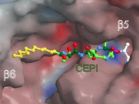Production of 5-aminovaleric and glutaric acid by metabolically engineered microorganism
Combining systems metabolic engineering and downstream process, bio-based production of 5-aminovaleric acid and glutaric acid, important C5 platform chemicals, engineered in Escherichia coli could be demonstrated for the first time
2012-12-20
(Press-News.org) We use many different types of chemicals and plastics for the convenience of our everyday life. The current sources of these materials are provided from petrochemical industry, using fossil oil as a raw material. Due to our increased concerns on the environmental problems and fossil resource availability, there has been much interest in producing those chemicals and materials from renewable non-food biomass through biorefineries. For the development of biorefinery process, microorganisms have successfully been employed as the key biocatalysts to produce a wide range of chemicals, plastics, and fuels from renewable resources. However, the natural microorganisms without modification are not suitable for the efficient production of target products at industrial scale due to their poor metabolic performance. Thus, metabolic capacities of microorganisms have been improved to efficiently produce desired products, the performance of which is suitable for industrial production of such products. Optimization of microorganism for the efficient production of target bioproducts has been achieved by systems metabolic engineering, which allows metabolic engineering at the systems-level.
5-aminovalic acid (5AVA) is the precursor of valerolactam, a potential building block for producing nylon 5, and can potentially be used as a C5 platform chemical for synthesizing 5-hydroxyvaleric acid, glutaric acid, and 1,5-pentanediol. It has been reported that a small amount of 5AVA is accumulated in Pseudomonas putida that has impaired L-lysine catabolism since 5AVA is a natural metabolite of L-lysine catabolism in P. putida. However, direct fermentative production of 5AVA has not yet been demonstrated, which might have great potential to open market for C5 chemicals and plastics.
In the paper published in Metabolic Engineering, a Korean research team led by Distinguished Professor Sang Yup Lee at the Department of Chemical and Biomolecular Engineering, Korea Advanced Institute of Science and Technology (KAIST), a premier science and engineering university in Korea, together with Dr. Seung Hwan Lee at Korea Research Institute of Chemical Technology (KRICT), a government supported research institute in Korea, and Prof. Si Jae Park at Myongji University in Korea, applied systems metabolic engineering approach to develop recombinant Escherichia coli for the production of 5-aminovaleric acid and glutaric acid, the promising C5 platform chemicals, by fermentation. Firstly, they constructed metabolic pathway to produce 5-aminovaleric acid (5AVA) using L-lysine as a direct precursor by employing two enzymes lysine 2-monooxygenase (DavB) and delta-aminovaleramidase (DavA). Secondly, metabolic pathway for the further conversion of 5AVA into glutaric acid was constructed by employing two more enzymes 5AVA aminotransferase (GabT) and glutarate semialdehyde dehydrogenase (GabD). Recombinant E. coli expressing DavB and DavA produced 5AVA using L-lysine as a direct precursor, and recombinant E. coli expressing DavB, DavA, GabT, and GabD produced glutaric acid from L-lysine. Finally, the L-lysine biosynthetic pathway of E. coli was systematically engineered to produce 5AVA from glucose. As a proof-of-concept demonstration, fermentation of this metabolically engineered E. coli strain successfully produced 5AVA from glucose. This study showcases the first microbial process for the production of 5AVA and glutatic acid as C5 platform chemicals by developing microbial strain through systems metabolic engineering.
###
This work is published in Metabolic Engineering (Elsevier): Park, S.J. et al., Metabolic engineering of Escherichia coli for the production of 5-aminovalerate and glutarate as C5 platform chemicals, Metabolic Engineering.
Further Contacts:
Dr. Sang Yup Lee, Distinguished Professor
KAIST
Daejeon, Korea
leesy@kaist.ac.kr, 82-42-350-3930 END
ELSE PRESS RELEASES FROM THIS DATE:
2012-12-20
PHILADELPHIA—Researchers at the Kimmel Cancer Center at Jefferson (KCC) (insert link to "Kimmel Cancer Center at Jefferson" www.kimmelcancercenter.org) have developed potentially game-changing diagnostic and prognostic genetic tests shown to better predict prostate cancer survival outcomes and distinguish clinically-relevant cancers.
The team, led by Richard G. Pestell, M.D., Ph.D., Director of the KCC and the Chair of the Department of Cancer Biology at Thomas Jefferson University, report their preclinical findings from a blinded, retrospective analysis of over 350 ...
2012-12-20
As the human population increases, so too do the demands and stresses on agriculture. In the January 2013 issue of International Journal of Plant Sciences, Penn State University Waller Professor of Plant Biology Dr. Sarah Assmann explores how the responses to environmental stresses by one small, genetically diverse plant species might illuminate possible approaches to addressing growing human demand for crop products amid decreasing resources.
In the article, Dr. Assmann describes how human population growth presents new challenges to twenty-first-century agriculture, ...
2012-12-20
A University of Colorado Cancer Center study in this month's edition of the Journal of Investigative Dermatology describes a new target and potential treatment for melanoma, the most dangerous form of skin cancer. MicroRNA can decide which genes in a cell's DNA are expressed and which stay silent. Melanoma tends to lack microRNA-26a, which makes the gene SODD go silent.
"It's a double negative," says Yiqun Shellman, PhD, investigator at the CU Cancer Center, associate professor at the CU School of Medicine, and the study's co-senior author. "miR-26a works to stop the ...
2012-12-20
New research examining the role of race and ethnicity in an individual's decision to become a donor for hematopoietic cell transplantation (HCT) identifies several factors associated with varied participation rates in national donor registries across racial/ethnic groups. Results of this first-of-its-kind study are published online today in Blood, the Journal of the American Society of Hematology (ASH).
Hematopoietic cell transplants serve as valuable treatments for a range of blood disorders, as they generate new, healthy blood cells to replace diseased cells. While ...
2012-12-20
This press release is available in German.
In their quest for new agents, pharmaceutical researchers test millions of substances all over the world. They like using color-forming reactions to identify new molecules. However, in intensively colored solutions or in the case of mixtures with multiple substances these tests fail. As part of his doctoral thesis, Martin Stein, member of staff at the Chair of Biochemistry at the Technische Universitaet Muenchen, developed a testing reaction based on magnetic resonance data. It helps find a specific pharmaceutical molecule ...
2012-12-20
The Seventies: Smog alert in the Ruhr area, acid rain, dying spruce trees in the Bavarian Forest. In those days, the solution was filter systems for the smokestacks in the Ruhr area. Today, people in the urban areas are suffering from high levels of pollution that is being caused by, among other things, automotive traffic. Particularly undesired: the nitrogen oxides (NOX). In the meantime, the European Union tightened the limit values even further; in many communities they are being exceeded. Michael Hüben of the Fraunhofer Institute for Molecular Biology and Applied Ecology ...
2012-12-20
St. Louis, MO – December 18, 2012 – Researchers at Aldrich Materials Science, a strategic technology initiative of Sigma-Aldrich Corporation (NASDAQ:SIAL) have discovered an innovative way to design an important class of three-dimensional (3D) hybrid structures, Metal Organic Frameworks (MOFs), under completely liquid-free conditions. High purity MOF products prepared by the liquid-free process may be ideally suited as rare earth containing materials for sensors and detectors, electronic or magnetic materials. The discovery also extends liquid-free preparation techniques ...
2012-12-20
This press release is available in German.
The study conducted by Prof. Frank Bradke's team provides indications on brain development and about the causes of diseases of the nervous system. The results have now been published in "Neuron".
Under the microscope, the brain appears as a network of intricate beauty comprising billions of nerve cells (the so-called "neurons") linked together. This network is engaged in a constant process of sharing information. The signals are transmitted from neuron to neuron through fine ramifications of the cell body. However, to acquire ...
2012-12-20
A researcher with the Faculty of Medicine & Dentistry and the Mazankowski Alberta Heart Institute is looking closely at a molecule linked to aortic aneurysms in the abdomen, and her findings could lead to a treatment to reduce swelling of the aortic artery, which would be a life-saving treatment.
Zamaneh Kassiri, a professor in the Department of Physiology, and Ratnadeep Basu, a PhD trainee in Kassiri's lab, have been looking at the role of a protein called TIMP3 in the vessels. Their most recent findings, published in The Journal of Biological Chemistry, shows that animal ...
2012-12-20
URBANA – Due to the introduction of exotic pests and pathogens, tree species are being eliminated one by one from forest ecosystems. In some cases, scientists can observe immediately how their loss affects the environment, whereas in other cases, creative puzzle solving and analysis reveal unexpected repercussions. In the case of the loss of the hemlock tree, University of Illinois landscape and ecosystem ecologist Jennifer Fraterrigo uncovered a surprising benefit to hardwood species.
Throughout much of the eastern United States, a pest called the hemlock woolly adelgid ...
LAST 30 PRESS RELEASES:
[Press-News.org] Production of 5-aminovaleric and glutaric acid by metabolically engineered microorganism
Combining systems metabolic engineering and downstream process, bio-based production of 5-aminovaleric acid and glutaric acid, important C5 platform chemicals, engineered in Escherichia coli could be demonstrated for the first time



